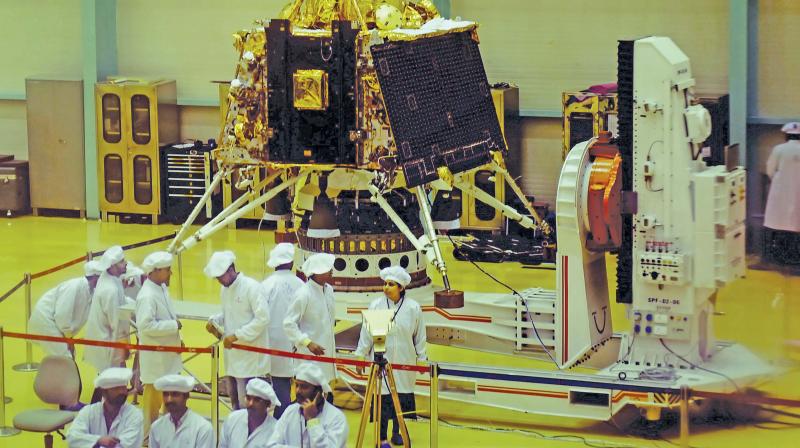Isro gears up to launch Chandrayaan-2 on July 15
Inspire future generations to undertake real life applications of science and technology.

Bengaluru: It’s the trickiest mission ever attempted by Indian space scientists, but Chandrayaan-2, scheduled for launch in the wee hours of July 15, could well secure a place in the sun for them as the first team to land a rover close to the South Pole of the Moon.
The orbiter-lander-rover mission, the country’s second outing to the Moon, will probe the lunar surface for signs of water as well as new sources of abundant energy and eventually help a crew to land on the earth’s nearest astral neighbour.
“We have left no stone unturned to make the lunar soft landing a success,” Dr K Sivan, chairman, Isro, told the media here on Wednesday, while explaining about the most complex mission being attempted by the space agency.
The total mission costs less than Rs 1,000 crore (Rs 603 crores for Chandrayaan-2 and Rs 350 crore for GSLV MK III rocket), but soft-landing on a territory never visited by any probes would be the most challenging part of this mission.
Describing the 15 minute-long final descent of the lander, ‘Vikram’, named after the late Dr Vikram Sarabhai, on September 6 or 7 as the “most terrifying moment”, Dr Sivan said it would a heart-in-the-mouth situation for everyone in the country as complicated operations and technical skills would be involved to ensure a smooth landing on the Moon.
Four hours later, the rover, 'Pragyan', would emerge from the lander and crawl for about 500 meters, tiptoeing its way around the South Pole at a speed of one cm a second, and analyze the lunar crust for water. "The rover will send pictures of the lunar surface within 20 minutes of landing," he added.
He said the South Pole was chosen both for convenience (a spot sans craters or boulders) and to carryout scientific studies on lunar soil. "From Science point of view, the South Pole is under shadow region more than North Pole, and because of this special aspect of South Pole, water is expected to be more, and also more minerals are expected to be there," he added.
While Chandrayaan-1 (launched in 2008) had 11 instruments -five from India, three from Europe, two from the US and one from Bulgaria -- and was credited with discovery of water on the lunar surface, Chandrayaan-2 would carry 13 from India (eight onboard the orbiter, three onboard the lander, and two onboard the rover), and one from Nasa. The orbiter and lander modules would be interfaced mechanically and stacked together as an integrated module and accommodated inside GSLV MK-III rocket for the 50-day-long ride to the Moon. Soon after the launch into an earth-bound orbit by the rocket, the integrated module would reach the lunar orbit using the orbiter propulsion module and subsequently, the lander would separate from orbiter and soft land at the predetermined site, close to the South Pole, explained Dr Sivan.
BOX
What Isro plans to achieve with Chandrayaan-2 mission:
1. Push the boundaries of scientific knowledge to unravel mysteries of the universe, and trace the origin and evolution of the Moon, thus fostering a new age of discovery.
2. Unleash innovation by throwing challenges at the youth of the country, and to spur future research and development.
3. Explore economic possibilities by strengthening ISRO's alliance with the industry as well as promote global alliances .
4. Inspire future generations to undertake real life applications of science and technology.
5. Expand India's footprint in space as the Moon is the best test-bed for proving technologies which are critical for future space explorations.
6. Expand on discoveries of Chandrayaan-I: Origin of water on Moon, estimate the amount of water on the lunar surface, below the surface and tenuous lunar exosphere.

